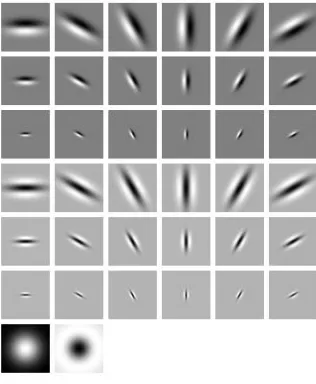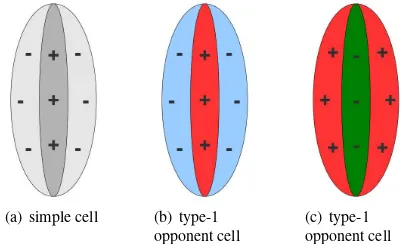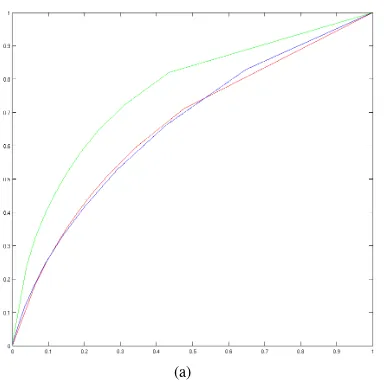COLOR TEXTONS FOR BUILDING DETECTION
Ronny H¨ansch and Olaf Hellwich
Technische Universit¨at Berlin Computer Vision and Remote Sensing; FR3-1
Franklinstr. 28/29; 10587 Berlin, Germany r.haensch@tu-berlin.de
KEY WORDS:feature extraction, textons, building detection, color information, filter
ABSTRACT:
Textons are known to be powerful operators in capturing textural properties of image regions. This paper proposes a new method to consistently combine structural cues as well as color information in an unified framework of color textons. They are used as features to detect buildings from optical imagery. Despite the simple classification algorithm, presented results are promising and show the usefulness of the proposed feature operator in remote sensing applications.
1 INTRODUCTION
The authors of (Julesz, 1981) define the term “textons” as “puta-tive units of pre-atten“puta-tive human texture perception”. During the last decades this biological concept has been adapted, extensively investigated, and improved by the computer vision community as for instance in (Malik et al., 1999) and (Zhu et al., 2005).
Nowadays, textons are used to solve various computer vision tasks like texture recognition (Burghouts and Geusebroek, 2006) or scene categorization (Battiato et al., 2008).
Despite the success in computer vision applications, textons are only seldom applied in remote sensing. One of the few examples is the work of (Garcia-Pineda et al., 2008) that uses use textons and an artificial neural network classifier to detect oil slicks in synthetic aperture radar (SAR) images. Another example of using gray-scale textons in remote sensing applications can be found in (He et al., 2008), where gray-value texton histograms serve as one of several features to detect buildings in polarimetric SAR images. The authors of (Sun and He, 2009) even propose a seg-mentation framework based on normalized cuts and color textons.
Since textons were shown to be very useful for recognition tasks from gray-valued images, there have been several attempts to ex-ploit not only spatial intensity variations, but color information as well. However, previous methods are mostly based on extensions, that are not fully consistent with the original texton algorithm. This work introduces a novel approach to consistently combine color and structural information within a unified framework for color textons.
Building detection is important for various remote sensing appli-cations as for example in urban change detection, city modelling and planning. Therefore, robust as well as accurate algorithms are needed, which are able to detect buildings of various size, form, and color in different environments and lighting conditions. Al-though buildings mostly follow a clear geometrical structure, the inner-class variability is very high, which complicates the recog-nition task.
The main purpose of this paper is the introduction of a novel color texton approach and the evaluation of its general usability in building detection tasks from optical imagery. That is why a standard classifier is applied to use color textons as features in
or-der to distinguish between the two classes of ’building’ and ’non-building’. Sophisticated classification algorithms would take sev-eral additional other cues into account like shape, context infor-mation, and prior knowledge. In this work Na¨ıve Bayes is used as a very basic classifier to provide a baseline performance estima-tion and to be able to better assess the advantages and limitaestima-tions of the proposed feature operator.
The results are compared to standard gray-level textons as well as another color texton method in order to evaluate the gain in performance achieved by this novel approach. The detection rate is improved by more than11%, while the false-positive rate is slighty decreased by3.5%at the same time.
2 GRAY-SCALE TEXTONS
A detailed description of textons is provided for instance in (Zhu et al., 2005). This section gives a brief introduction of standard gray-scale textons in order to familiarize the reader with the key-points of this concept. Color textons as proposed by this work and explained in the following section 3 are a consistent extension of the here described method.
Figure 1: MR8 filter-bank
International Archives of the Photogrammetry, Remote Sensing and Spatial Information Sciences, Volume XXXVIII-4/W19, 2011 ISPRS Hannover 2011 Workshop, 14-17 June 2011, Hannover, Germany
The first step is the convolution of a set of (gray-scale) images with a certain filter-bank. An often used example is the MR8-filter-bank (Varma and Zisserman, 2005) illustrated in figure 1. This specific filter-bank consists of38linear filters of different order, scale, and orientation. Only the maximum response of dif-ferent orientations of each orientation-dependent filter is used in order to derive rotation invariance as well as to reduce the num-ber of output dimensions. Therefore, the output of the application of this filter-bank to a gray-scale image is one eight-dimensional vector of filter responses for each pixel.
One of the basic assumptions of the texton framework is, that similar textures within the image will result in similar signatures of filter responses. The k-means algorithm finds a pre-defined number of dominant signatures in a subsequent clustering step. The cluster centers serve as signature prototypes and are named textons. Depending on the number of clusters it is assumed that this codebook is able to represent all dominant textures within the actual image data.
Since the filter response differs significantly at different positions within a textured area, a single cluster cannot represent a specific texture in general. Rather, one cluster corresponds to a certain part of a texture, which may or may not be shared with other tex-tures. However, the collective similarity to several cluster centers is able to accurately describe the whole texture. Different tex-tures will correspond to different sets of similarities to the learnt cluster centers.
Therefore, a local texton histogram is calculated over a small neighborhood around each pixel. It represents the relative oc-currence of different filter signatures and is able to serve as a powerful texture descriptor. This histogram is exploited by fur-ther analysis, for instance classification algorithms.
3 COLOR TEXTONS
Texture is able to serve as a powerful feature for recognition tasks. Nevertheless, some object categories are far easier to rec-ognize by use of radiometric information or a combination of tex-ture and color.
In (Sun and He, 2009) color is included into the texton framework at the level of filter responses by concatenating the filter response vector with the RGB-color vector. The distinction between color and textural information neglects the potential different structural signature within and between the different color channels. One approach to overcome this problem is to independently apply the filter-bank to each color-channel. The authors of (Burghouts and Geusebroek, 2006) investigate two further possibilities to exploit color information. The first method includes color directly at tex-ton level. Color invariants are used to handle shading and shadow. The second method uses the standard gray-value texton approach and applies a color-dependent weighting as post-processing step.
All those methods suffer from the fact, that they do not analyse the whole spectrum of possible color-structure combinations.
Gray-scale textons have their origin in a biological concept. A remarkable fact about the filters of the MR8 filter-bank (see fig-ure 1) is their analogy to the behavior of simple-cells in the visual cortex of mammals.
The receptive field of simple-cells consists of clearly distinct ex-citatory as well as inhibitory areas, which result in zero activation under diffuse lighting (Nicholls, 2001). Figure 2(a) illustrates an
exemplary receptive field of a simple-cell. An excitatory “on”-part at the center is surrounded by inhibitory “off”-areas. The optimal stimulus for such a cell is a small bright bar surrounded by dark areas. It corresponds to the filters of order two in the MR8 filter-bank. There are simple-cells with receptive fields which match other types of filters, too.
(a) simple cell (b) type-1 opponent cell
(c) type-1 opponent cell
Figure 2: Illustration of receptive fields of cells within the visual cortex
This work follows the idea of biologically inspired textons to ex-ploit color information. There are different kinds of cells in the visual cortex, which are sensitive to color information. One of them is named type-1 opponent cell and has an excitatory or in-hibitory center surrounded by antagonistic areas (Nicholls, 2001) similar to color-insensitive simple-cells. However, both areas are sensitive to potentially different colors as illustrated exemplarily in figure 2(b) and 2(c).
For that reason, this work proposes the usage of a color-dependent filter-bank. Basically, the same filters as in the standard gray-scale texton framework are used, namely the MR8 filter-bank. Besides the Gaussian filter, all kernels of this filter-bank have a positive (excitatory) as well as a negative (inhibitory) part. The positive and negative areas of each filter kernel are applied to dif-ferent color channelsiandjof the imageI. The summation of both individual outputs leads to the final filter responsefij.
fij(x) = X one of the kernels from the filter-bank with domainD.
The result of the application of the MR8 filter-bank in the stan-dard texton framework are38filter outputs, which are reduced to8dimensions by using only the maximum response of all ori-ented versions of the same filter. The set of convolutions defined by equation 1 leads to37·9 + 3 = 336filter responses for all 9possible color-channel combinations. Even if only the maxi-mum response over different orientations is used, there are still 66remaining filter responses. Such a high-dimensional feature space might cause severe problems during the subsequent clus-tering step.
This work uses principle component analysis (PCA) as dimen-sionality reduction technique instead of the maximum response approach. Only the firstNprinciple components which explain 95% of the variance are kept for further analysis. During the experiments described in section 4,N was always found to be International Archives of the Photogrammetry, Remote Sensing and Spatial Information Sciences, Volume XXXVIII-4/W19, 2011
ISPRS Hannover 2011 Workshop, 14-17 June 2011, Hannover, Germany
less than20. This shows that PCA is able to significantly reduce the dimensionality of this filter response space, while using only statistically important information instead of an arbitrary subset. Additionally, the orientation dependency of the oriented filters is lost due to the transformation into the eigenvector space.
Due to the application of PCA linear correlations within the data are removed and the covariance matrix is diagonalized, which is advantageous for the subsequent clustering process. As in the standard texton approach k-means is used as clustering algorithm.
Afterwards a texton histogram is estimated from a small neigh-borhood around each pixel and used as descriptor, which unified captures texture as well as color information.
4 BUILDING DETECTION
Like most man-made objects buildings consist of clear defined geometrical structures, which are often the most dominant visual features. This is particularly true for orthorectified air-born im-ages, where the roof is the dominant visible building part. Paral-lel and orthogonal lines, rectangles and other simple geometrical objects occur far more often in images of buildings than for ex-ample in images of forests. Even other man-made structures as for example streets consist of other arrangements of those geo-metrical primitives. That is why, textural properties represent a well suited cue for building detection. Another important charac-teristic of roof tops is color, since the variability of roof colors is rather low and distinct from other object classes.
The main purpose of this paper is the introduction of color tex-tons as defined by the previous section and to evaluate their prin-ciple usability in building detection tasks. Therefore, instead of highly sophisticated classification algorithms which would take several other cues (like shape, context information, prior knowl-edge, etc.) into account, only a very basic classifier is used.
Na¨ıve Bayes assumes the statistical independence of the indi-vidual dimensions of the feature space. This assumption does not hold in general, but is mostly clearly wrong. Nevertheless, it still often leads to successful classifications and even outperforms more complicated models. Due to its simple implementation and clear statistical interpretability it serves as a standard baseline ap-proach.
Given the feature vectorf, the classc∗
with the largest posterior probabilityP(c∗
|f)is defined as the final classification result. According to Bayes’ TheoremP(c|f)can be modelled as
P(c|f) = p(f|c)·P(c)
p(f) ∝p(f|c)·P(c) (4)
The optimal class decisionc∗
is estimated under the assumption of a uniform prior as well as independent features by
c∗= arg max
c P(c|f) = arg maxc p(f|c) = arg maxc F
Y
i=1 p(fi|c)
(5) whereFis the number of features.
Figure 3(a) shows an examplarly part of the used data set. The image shows a small area of the city of Dorsten, Germany. In figure 3(c) the final classification result is visualized.
From the336-component filter response vector, only the18first principle components are kept and used as input for k-means. The
(a) Dorsten c
”Geobasisdaten: Land NRW, Bonn, 2111/2009”
(b) Reference Data c
”Geobasisdaten: Land NRW, Bonn, 2111/2009”
(c) Classification Result
Figure 3: Image and reference data, as well as classification result
number of clusters was fixed to50. To calculate the texton his-togram window size was set to10. Codebook generation as well as the training of the classifier were performed using a different part of the dataset.
Figure 4 shows the ROC statistics of the proposed color-textons (green), the standard gray-value textons (red), as well as another approach (blue) to include color information into the texton frame-work by simply applying the filter-bank to all channels individ-ually. The according error rates are estimated by4-fold cross-validation.
International Archives of the Photogrammetry, Remote Sensing and Spatial Information Sciences, Volume XXXVIII-4/W19, 2011 ISPRS Hannover 2011 Workshop, 14-17 June 2011, Hannover, Germany
(a)
Figure 4: ROC curves under usage of different textons
green: proposed method; blue: filters independently applied to all color-channels; red: grey-scale textons
Grey-valued textons and the naive approach of including color by simply applying the filter-bank to each channel independently show no significant difference. However, the proposed method is significantly better than both of them.
Even under usage of a very simple classification framework promis-ing results are achieved. The actual detection rate increased from 40.1%for grey-valued textons to51.7%correctly classified build-ing pixels for the proposed color textons. At the same time the false-positive rate slightly dropped from18.6%to15.1%.
It should be noted that no context or prior knowledge was used. Spatial relations were only analysed in terms of spatially extended filters and local pixel neighborhoods to calculate texton histograms.
Although a rather large percentage of building pixels is not cor-rectly labelled, the larger part of most buildings is. The majority of false-positives are very close to actual buildings or occur be-tween two buildings which are close to each other. Those facts indicate that the proposed color textons are indeed capable of capturing radiometric and textural information relevant to detect buildings from optical imagery.
5 CONCLUSION AND FUTURE WORK
Despite the simple classification method the results are already very promising. It was shown, that they outperform not only stan-dard grey-valued textons, but naive approaches to include color, too.
Future work will investigate the performance of the proposed color textons for further computer vision tasks. The implications of PCA with respect to the usage of a specific filter-bank will be addressed, as will be other clustering techniques.
One critical point of the proposed algorithm are the computa-tional costs. The number of necessary convolutions during code-book generation, PCA, and the number of iterations during the clustering process lead to rather long processing times. Future research will concentrate on ways how to reduce the amount of time needed to extract color textons at least during the application phase of the proposed framework.
REFERENCES
Battiato, S., Farinella, G., Gallo, G. and Ravi, D., 2008. Scene categorization using bag of textons on spatial hierarchy. In: 15th IEEE International Conference on Image Processing, pp. 2536– 2539.
Burghouts, G. and Geusebroek, J., 2006. Color textons for texture recognition. In: British Machine Vision Conference, Vol. III, pp. 1099–1108.
Garcia-Pineda, O., MacDonald, I. and Zimmer, B., 2008. Syn-thetic aperture radar image processing using the supervised textural-neural network classification algorithm. In: IEEE Inter-national Geoscience and Remote Sensing Symposium, Vol. IV, pp. 439–442.
He, W., Reigber, A. and Hellwich, O., 2008. Building extraction from polarimetric sar data using mean shift and conditional ran-dom fields. In: Proceedings of EUSAR 2008, Vol. 3, pp. 1265– 1268.
Julesz, B., 1981. Textons, the elements of texture perception and their interactions. Nature 290, pp. 91–97.
Malik, J., Belongie, S., Shi, J. and Leung, T., 1999. Textons, contours and regions: Cue integration in image segmentation. In: The Proceedings of the Seventh IEEE International Conference on Computer Vision, Vol. 2, IEEE, pp. 918–925.
Nicholls, J., 2001. From Neuron to Brain. Palgrave Macmillan.
Sun, F. and He, J., 2009. The remote-sensing image segmentation using textons in the normalized cuts framework. In: International Conference on Mechatronics and Automation, pp. 1877–1881.
Varma, M. and Zisserman, A., 2005. A statistical approach to texture classification from single images. International Journal of Computer Vision 62, pp. 61–81.
Zhu, S.-C., Guo, C.-E., Wang, Y. and Xu, Z., 2005. Textons, the elements of texture perception and their interactions. Inter-national Journal of Computer Vision - Special Issue on Texture Analysis and Synthesis 62, pp. 121–143.
International Archives of the Photogrammetry, Remote Sensing and Spatial Information Sciences, Volume XXXVIII-4/W19, 2011 ISPRS Hannover 2011 Workshop, 14-17 June 2011, Hannover, Germany



